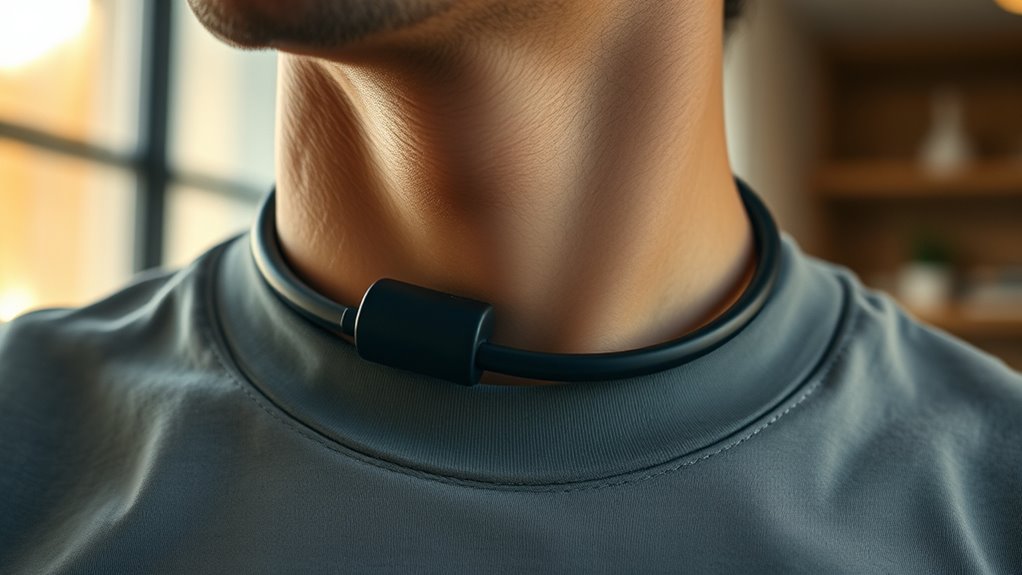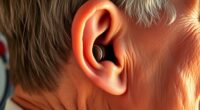Neckloops help boost sound for T-coil users by creating magnetic fields that transmit audio directly to compatible hearing aids. They offer clear, focused sound while reducing background noise, making conversations and entertainment easier to hear. Connecting is simple and wireless, letting you enjoy hands-free listening comfortably. To get the best experience, make sure your devices support T-coil functionality and choose quality neckloops. Keep going to discover tips that will maximize your listening clarity.
Key Takeaways
- Neckloops create magnetic fields that transmit audio directly to T-coil-equipped hearing aids, improving sound clarity.
- They are simple, wireless devices worn around the neck, providing discreet and hands-free listening.
- Compatibility depends on hearing aid or device support for T-coil; verify before purchasing.
- Using quality, well-shielded neckloops reduces static and interference, ensuring stable sound transmission.
- Proper setup and matching audio sources enhance natural sound quality and overall listening experience.

Have you ever wondered how neckloops enhance your listening experience with hearing aids or assistive devices? If you’re using a hearing aid with a T-coil, a neckloop can be a game-changer. It works by creating a magnetic field that your T-coil picks up, directly transmitting sound from compatible devices like public sound systems, phones, or TVs. The result is clearer, more focused audio without background noise, making conversations, entertainment, and alerts much easier to understand.
One of the biggest advantages of using a neckloop is its simplicity. Once you connect the device to a compatible audio source—whether it’s a public transmitter or your personal device—you can wear the neckloop around your neck. The magnetic field it produces is picked up seamlessly by your T-coil, reducing the need for cumbersome wires or bulky headphones. This wireless connectivity allows for a discreet and hands-free listening experience, which many users find both convenient and comfortable.
Using a neckloop offers a simple, discreet, wireless way to enjoy clear, hands-free audio from compatible devices.
However, to get the most out of your neckloop, you need to be aware of potential compatibility issues. Not all hearing aids or assistive listening devices are equipped with T-coils, so it’s vital to verify whether your device supports this feature. Even if it does, some neckloops are designed for specific frequencies or power levels, so compatibility can sometimes be a concern. Using an incompatible neckloop might result in weak audio signals, static, or no sound at all. To avoid frustration, always check the specifications of both your hearing aid and the neckloop before making a purchase.
Wireless connectivity isn’t just about convenience; it also impacts audio quality. A well-matched neckloop and audio source provide a stable, clear signal, but poor compatibility can lead to interruptions or inconsistent sound quality. Some users encounter interference from other electronic devices, which can cause static or dropouts. To minimize these issues, choose a high-quality neckloop with good shielding and ensure your audio source is compatible and properly configured. Additionally, understanding the importance of color accuracy in audio devices can help you select equipment that delivers clearer, more natural sound.
Frequently Asked Questions
Can Neckloops Interfere With Other Electronic Devices?
You might wonder if neckloops interfere with other electronic devices. Generally, electromagnetic interference from neckloops is minimal, but it can occasionally affect device compatibility, especially with sensitive equipment. To prevent issues, keep your neckloop at a reasonable distance from other electronics. Most modern devices are designed to resist interference, so with proper use, your neckloop shouldn’t cause significant problems or disruptions.
Are Neckloops Compatible With All Hearing Aids?
While not all hearing aids are compatible with every neckloop type, many modern devices support hearing aid compatibility. You might find that some neckloops work seamlessly, while others require specific features like T-coil support. It’s essential to verify your hearing aid’s specifications to guarantee compatibility. Don’t assume all neckloops suit your device—consult your audiologist or look for models designed for your hearing aid’s type.
How Do I Troubleshoot if the Neckloop Isn’t Working?
If your neckloop isn’t working, start by checking neckloop compatibility with your hearing aid. Make certain it’s properly connected and powered on. For sound quality troubleshooting, adjust the placement of the neckloop and make sure your hearing aid’s T-coil is activated. Test in different environments to identify interference. If issues persist, try a different neckloop or contact your audiologist for further assistance.
What Are the Best Practices for Maintaining My Neckloop?
To keep your neckloop working well, follow simple maintenance tips and cleaning procedures. Regularly wipe it with a soft, dry cloth to remove dirt and sweat. Avoid using harsh chemicals that could damage the wiring. Store it in a cool, dry place when not in use. Check the cord for frays or damage, and replace it if needed. Proper care guarantees your neckloop stays reliable and lasts longer.
Are There Wireless Alternatives to Traditional Neckloops?
You might find wireless alternatives to traditional neckloops, like Bluetooth-enabled devices or FM transmission systems, quite convenient. Wireless Bluetooth options connect seamlessly to smartphones or tablets, offering freedom from cords. FM transmission devices can transmit sound directly to compatible hearing aids or T-coil systems. These options provide reliable audio quality and greater mobility, making them excellent choices if you want to avoid the hassle of wired neckloops.
Conclusion
Now that you know how neckloops amplify sound for T-coil users, you can confidently explore better listening experiences. Did you know that over 80% of hearing aids now include T-coil technology? That means millions are already benefiting from neckloops’ simplicity and effectiveness. So, give it a try—boost your hearing and stay connected in any environment. With neckloops, better sound is just a loop away!











